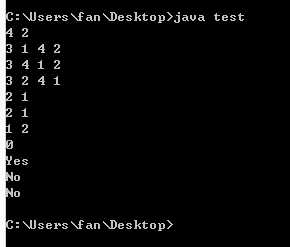7-4 是否同一棵二叉搜索树(25 分)
给定一个插入序列就可以唯一确定一棵二叉搜索树。然而,一棵给定的二叉搜索树却可以由多种不同的插入序列得到。例如分别按照序列{2, 1, 3}和{2, 3, 1}插入初始为空的二叉搜索树,都得到一样的结果。于是对于输入的各种插入序列,你需要判断它们是否能生成一样的二叉搜索树。
输入格式:
输入包含若干组测试数据。每组数据的第1行给出两个正整数N (≤10)和L,分别是每个序列插入元素的个数和需要检查的序列个数。第2行给出N个以空格分隔的正整数,作为初始插入序列。最后L行,每行给出N个插入的元素,属于L个需要检查的序列。
简单起见,我们保证每个插入序列都是1到N的一个排列。当读到N为0时,标志输入结束,这组数据不要处理。
输出格式:
对每一组需要检查的序列,如果其生成的二叉搜索树跟对应的初始序列生成的一样,输出“Yes”,否则输出“No”。
输入样例:
4 2
3 1 4 2
3 4 1 2
3 2 4 1
2 1
2 1
1 2
0
输出样例:
Yes No No
思路:1.创建树的节点类型
2.创建树类型
3.创建一个树型链表,储存树
4.比较树是否相同
import java.util.Scanner; //创建树的节点 class Node { int key; Node left; Node right; Node next; public Node() { key=-1; left=null; right=null; next=null; } public Node(int key) { this.key=key; left=null; right=null; next=null; } } //创建树 class tree { Node root; Node leftchild; Node rightchild; tree next; public tree() { root=new Node(); leftchild=new Node(); rightchild=new Node(); next=null; root.left=leftchild; root.right=rightchild; } public boolean isEmpty() { return(root.key==-1); } //向树中加入节点 public void addNode(Node node) { if (isEmpty()) { root=node; root.left=null; root.right=null; } Node temp=root; if(!isEmpty()) { if ((node.key<root.key)&&(root.left==null)) { root.left=node; } if ((node.key>root.key)&&(root.right==null)) { root.right=node; } if ((node.key<root.key)&&(root.left!=null)) { root=root.left; addNode(node); } if (node.key>root.key&&root.right!=null) { root=root.right; addNode(node); } } root=temp; } public Node getRoot() { return this.root; } } //创建链表,由于不知道给出数据的组数,因此用一个动态的容器来装建立的树 class list { tree head; tree rear; public list() { head=new tree(); rear=new tree(); head=rear; } public boolean isEmpty() {return(head==rear);} public void addTree(tree t) { if (isEmpty()) { head.next=t; rear=t; rear.next=null; } else { rear.next=t; rear=t; } } } //测试类 class test { public static void main(String[] args) { Scanner sc=new Scanner(System.in); list arr=biuldTree(sc); tree temp=arr.head.next; while (temp.next!=null ) { if(arr.head.next.getRoot().key==temp.next.getRoot().key) { boolean result=isSame(arr.head.next.getRoot(),temp.next.getRoot()); if (result) System.out.println("Yes"); else System.out.println("No"); temp=temp.next; } else { arr.head=temp; temp=temp.next; boolean result=isSame(arr.head.next.getRoot(),temp.next.getRoot()); if (result) System.out.println("Yes"); else System.out.println("No"); temp=temp.next; } } } //建立树 public static list biuldTree(Scanner sc) { int N=sc.nextInt(); //int num=sc.nextInt(); list arr=new list(); while (N!=0) { int num=sc.nextInt(); for (int i=0;i<=num ; i++) { tree t=new tree(); for (int a=0;a<N ;a++ ) { Node node=new Node(); node.key=sc.nextInt(); t.addNode(node); } arr.addTree(t); } N=sc.nextInt(); } return arr; } //比较两棵树是否相同 public static boolean isSame(Node root1,Node root2) { if (root1==null&&root2==null) { return true; } if ((root1==null&&root2!=null)||(root1!=null&&root2==null)) { return false; } if (root1.key!=root2.key) { return false; } if ((root1.key==root2.key)&&(root1.left==null)&&(root2.left==null)) { return(isSame(root1.right,root2.right)); } if ((root1.key==root2.key)&&(root1.right==null)&&(root2.right==null)) { return(isSame(root1.left,root2.left)); } else return((isSame(root1.left,root2.left))&&(isSame(root1.right,root2.right))); } }
测试结果
